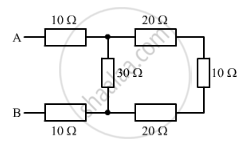Advertisements
Advertisements
Question
2Ω resistor A, 1Ω resistor B and 4Ω resistor C are connected in parallel. The combination is connected across a 2V battery of negligible resistance. Draw the diagram of the arrangement and calculate:
(i) The current in each resistor A and C,
(ii) The current through battery.
Solution
The diagram of the arrangement is shown in given figure.

(i) The current in resistor A is I1 = `"V"/"R"_1 = 2/2 = 1.0`A
The current in resistor B is I2 = `"V"/"R"_2 = 2/1 = 2.0`A
The current in resistor B is I3 = `"V"/"R"_3 = 2/4 = 0.5`A
(ii) The current through battery
I = I1 + I2 + I3
I = 1.0 + 2.0 + 0.5
= 3.5 Ampere.
APPEARS IN
RELATED QUESTIONS
When a 4 Ω resistor is connected across the terminals of a 12 V battery, the number of coulombs passing through the resistor per second is:
(a) 0.3
(b) 3
(c) 4
(d) 12
Give one example to show how the resistance depends on the nature of material of the conductor.
How does the resistance of a wire change when:
its length is tripled?
What is (a) highest, and (b)Ω lowest, resistance which can be obtained by combining four resistors having the following resistances?
4 Ω, 8 Ω, 12 Ω, 24 Ω

In series combination of resistances ______.
Six equal resistors of 1 ohm each are connected to form the sides of a hexagon ABCDEF. Calculate the resistance offered by the combination if the current enters at A and leaves it at D.
Illustrate-combination of cells e.g., three cells, in series, explaining the combination briefly. Obtain an expression for current ‘i’ in the combination.
A metal wire of resistance 6 Ω is stretched so that its length is increased to twice its original length. Calculate its new resistance.
